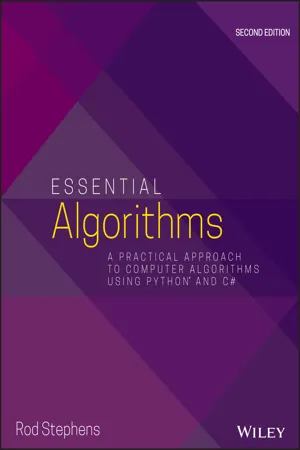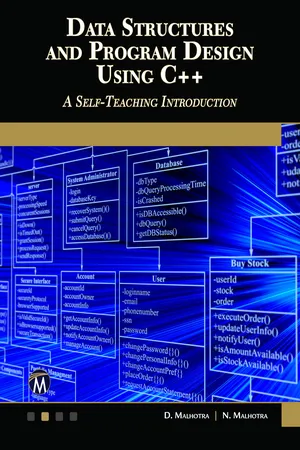Computer Science
Python Arrays
Python arrays are data structures used to store a collection of elements of the same type. They are similar to lists but are more efficient for numerical operations. Arrays in Python are provided by the array module and can be created using the array() function, allowing for efficient manipulation and storage of data in a contiguous block of memory.
Written by Perlego with AI-assistance
Related key terms
6 Key excerpts on "Python Arrays"
- eBook - ePub
Essential Algorithms
A Practical Approach to Computer Algorithms Using Python and C#
- Rod Stephens(Author)
- 2019(Publication Date)
- Wiley(Publisher)
CHAPTER 4 ArraysArrays are extremely common data structures. They are intuitive, easy to use, and supported well by most programming languages. In fact, arrays are so common and well understood that you may wonder whether there's much to say about them in an algorithms book. Most applications use arrays in a relatively straightforward manner, but special-purpose arrays can be useful in certain cases, so they deserve some attention here.This chapter explains algorithmic techniques that you can use to make arrays with nonzero lower bounds, save memory, and manipulate arrays more quickly than you can normally.NOTE
Python does not have arrays, but lists can do the same things in most cases.Python also does not have multidimensional lists, but you can use a list of lists instead. For example, instead of an array with an entry at position [i, j] , you can use a list of lists with an entry at position [i][j] .Basic Concepts
An array is a chunk of contiguous memory that a program can access by using indices—one index per dimension in the array. You can think of an array as an arrangement of boxes where a program can store values.Figure 4.1 illustrates one-, two-, and three-dimensional arrays. A program can define higher-dimensional arrays, but trying to represent them graphically is hard.You can think of one-, two-, and three-dimensional arrays as arrangements of boxes where a program can store values.Figure 4.1:Typically, a program declares a variable to be an array with a certain number of dimensions and certain bounds for each dimension. For example, the following code shows how a C# program might declare and allocate an array named numbers - eBook - ePub
Data Structures and Program Design Using Java
A Self-Teaching Introduction
- D. Malhotra, N. Malhotra(Authors)
- 2020(Publication Date)
- Mercury Learning and Information(Publisher)
3ARRAYS
3.1 Introduction
In the previous chapter we studied the basics of programming in data structures and Java in which we aimed to design good programs, where a good program refers to a program which runs correctly and efficiently by occupying less space in the memory, and also takes less time to run and execute. Undoubtedly, a program is said to be efficient when it executes with less memory space and also in minimal time. In this chapter, we will learn about the concept of arrays. An array is a user-defined data type that stores related information together. Arrays are discussed in detail in the following sections.3.2 Definition of an Array
An array is a collection of homogeneous (similar) types of data elements in contiguous memory. An array is a linear data structure, because all elements of the array are stored in linear order. Let us take an example in which we have ten students in a class, and we have been asked to store the marks of all ten students; then we need a data structure known as an array.Figure 3.1. Representation of an array of ten elements.In the previous example, the data elements are stored in the successive memory locations and are identified by an index number (also known as the subscript), that is, Ai or A[i]. A subscript is an ordinal number which is used to identify an element of the array. The elements of an array have the same data type, and each element in an array can be accessed using the same name.Frequently Asked Questions
1. What is an array? How can we identify an element in the array?Ans: An array is a collection of homogeneous (similar) types of data elements in contiguous memory. An element in an array can be identified by its index number, which is also known as a subscript.3.3 Array Declaration
We know that all variables must be declared before they are used in the program. Therefore, the same concept also holds with array variables. An array must be declared before it is used. During the declaration of an array, the size of the array has to be specified. Declaring an array involves the following specifications: - eBook - ePub
- D. Malhotra, N. Malhotra(Authors)
- 2019(Publication Date)
- Mercury Learning and Information(Publisher)
3ARRAYS
In This Chapter• Introduction• Definition of an array• Array declaration• Array initialization• Calculating the address of array elements• Analyzing an algorithm• Abstract data types• Declaration of two-dimensional arrays• Operations on 2-D arrays• Multidimensional arrays/ N-dimensional arrayys• Calculating the address of 3-D arrays• Arrays and pointers• Array of pointers• Arrays and their applications• Sparse matrices• Types of sparse matrices• Representation of sparse matrices• Summary• Exercises3.1Introduction
We have already studied the basics of programming in data structures and C++ in the previous chapter in which we aimed to design good programs, where a good program refers to a program which runs correctly and efficiently by occupying less space in the memory, and also takes less time to run and execute. Undoubtedly, a program is said to be efficient when it executes with less memory space and also in minimal time. In this chapter, we will learn about the concept of arrays. An array is a user-defined data type that stores related information together. Arrays are discussed in detail in the following sections.3.2Definition of an Array
An array is a collection of homogeneous (similar) types of data elements in contiguous memory . An array is a linear data structure because all elements of the array are stored in linear order. Let us take an example in which we have ten students in a class, and we have been asked to store the marks of all ten students; then we need a data structure known as an array.FIGURE 3.1 .Representation of an array of 10 elements.In the previous example, the data elements are stored in the successive memory locations and are identified by an index number (also known as the subscript), that is, Ai or A[i]. A subscript is an ordinal number which is used to identify an element of the array - eBook - ePub
50 Algorithms Every Programmer Should Know
An unbeatable arsenal of algorithmic solutions for real-world problems
- Imran Ahmad(Author)
- 2023(Publication Date)
- Packt Publishing(Publisher)
Table 2.1 :
Table 2.1: Python Data Structures Let us look into them in more detail in the upcoming subsections.Data Structure Brief Explanation Example List An ordered, possibly nested, mutable sequence of elements ["John", 33,"Toronto", True] Tuple An ordered immutable sequence of elements ('Red','Green','Blue','Yellow') Dictionary An unordered collection of key-value pairs {'brand': 'Apple', 'color': 'black'} Set An unordered collection of elements {'a', 'b', 'c'} Lists
In Python, a list is the main data type used to store a mutable sequence of elements. The sequence of elements stored in the list need not be of the same type.A list can be defined by enclosing the elements in [ ] and they need to be separated by a comma. For example, the following code creates four data elements together that are of different types:list_a = ["John" , 33 ,"Toronto" , True ] print (list_a)['John', 33, 'Toronto', True] In Python, a list is a handy way of creating one-dimensional writable data structures, which are especially needed at different internal stages of algorithms.Using lists
Utility functions in data structures make them very useful as they can be used to manage data in lists. Let’s look into how we can use them:- List indexing : As the position of an element is deterministic in a list, the index can be used to get an element at a particular position. The following code demonstrates the concept:
bin_colors=['Red' ,'Green' ,' Blue' ,'Yellow' ]The four-element list created by this code is shown in Figure 2.1 :Figure 2.1: A four-element list in Python Now, we will run the code:bin_colors[1 ]'Green'Note that Python is a zero-indexing language. This means that the initial index of any data structure, including lists, will be 0 . Green , which is the second element, is retrieved by index 1 – that is, bin_colors[1]
- eBook - ePub
Learn C Programming from Scratch
A step-by-step methodology with problem solving approach (English Edition)
- Mohammad Saleem Mir(Author)
- 2024(Publication Date)
- BPB Publications(Publisher)
HAPTER 5Arrays IntroductionIn this chapter, we will explore various topics related to arrays, string manipulation, and matrices in the context of programming. Arrays, which are one-dimensional structures, allow us to store and manipulate a collection of elements. We will learn how to perform operations on arrays, such as accessing elements and modifying their values. Additionally, we will delve into string manipulation, understanding how to work with strings effectively. Furthermore, we will delve into matrices and explore how to pass a two-dimensional matrix to a function.Structure In this chapter, we will cover the following topics:- Arrays (One-dimensional array)
- Array manipulation
- String manipulation
- Matrices
- Passing 2-D matrix to a function
The objective of this chapter is to provide a comprehensive understanding of arrays, string manipulation, and matrices. By the end of this chapter, you will be equipped with the knowledge and skills necessary to manipulate arrays effectively, perform string operations efficiently, and work with matrices in programming. Through practical examples and explanations, we aim to enable you to apply these concepts in your coding projects.Arrays: One-dimensional arrayIn the C programming language, arrays are a fundamental type of data structure. They offer a practical and effective approach to handling and storing identical data items. Understanding arrays is crucial for creating effective and reliable software, whether you are an expert programmer or a newbie learning C. We may store a fixed-size collection of identical-type objects using the C data structure called an array. Arrays can group related data objects associated with a single name. Arrays allow for the contiguous (one after the other) storage of a fixed-size sequential collection of objects of the same kind. However, it is sometimes more helpful to conceive an array as a group of variables of identical type. Since we assign a name to all the elements of an array, it is imperative to identify the individual elements of an array uniquely. To access individual elements of an array, we use a unique integer called index, - eBook - ePub
Think AI
Explore the flavours of Machine Learning, Neural Networks, Computer Vision and NLP with powerful python libraries (English Edition)
- Swapnali Joshi Naik(Author)
- 2022(Publication Date)
- BPB Publications(Publisher)
The data structure is the way of organizing and storing data. As any AI programming involves managing a large amount of data, it is important for us to know two major data structures used in Python, i.e., Lists and Dictionaries.Lists
It is a collection of data that can store heterogeneous/mixed types of data under one name. Each data element can be accessed through indexes such as array elements, separated by a comma, and enclosed within [ ] square brackets. Following are the examples of lists:
Following are the operations which you can perform on lists:In [] Roll_no=[11,12,13,14,15,16] Marks=[56,7,34,90,78.2] Name=["ankita", "aditya", "renu", "john"] List1=["Python",1,"hello",67.8] #mixed data type Operation Description Example Access single element Using the index, the list index starts from 0 e.g. AI=["Python", "machine learning", "Deep Learning", "NLP", "Computer vision"]AI [1] will give "machine learning" AI [3] will give "NLP" Access sequence of elements By specifying the range as [m:n], it starts from mth index and ends at n−1 indexAI [2:4] gives "deep learning" and "NLP" Getting the size By using len() functionlen[AI] gives 5Adding new element By using the append function will add a new element at the end. AI.append("NLU") Deleting an element By using the remove function will delete the specifies element from the list AI.remove("machine learning") Iterating list elements By using for loop as shown in the example for i in AI: print(i) Table 2.1: List operationsDictionary
Python dictionary is a key component of any program. Just like we have word dictionaries, here we store that data based on key: value pairs in Python dictionary. It is unordered and the key should be unique. We can store the subjects with subject code as the key such as:
Learn about this page
Index pages curate the most relevant extracts from our library of academic textbooks. They’ve been created using an in-house natural language model (NLM), each adding context and meaning to key research topics.





